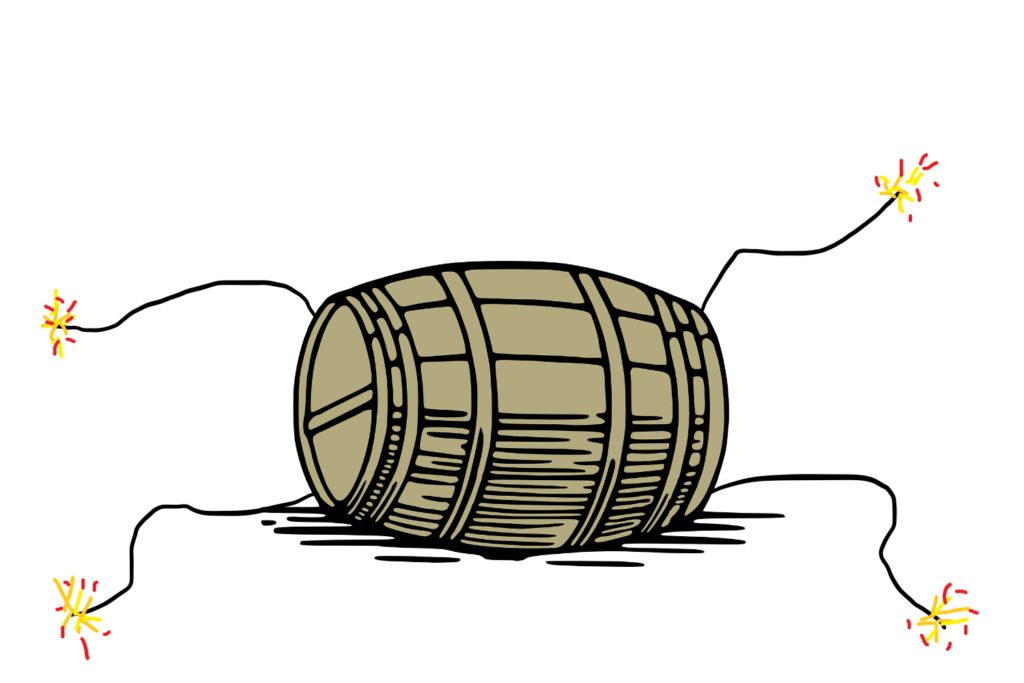Right now, Asia is a powderkeg with several simultaneously lit fuses.

There are at least four conflicts in Asia from which neither side can afford to back down, as the stakes are too great, there is no prospect of a do-over, and backing down would mean losing the whole fight.
They are:
- USA vs. China over trade.
- China vs. Hong Kong over Hong Kong’s status.
- India vs. Pakistan over Kashmir.
- Iran in the Persian Gulf.
Let’s go one by one, in no special order:
INDIA VS. PAKISTAN
Days ago, India moved to abolish the special status of “its half” of Kashmir, and absorb it as a regular part of the country. This has been accompanied by a buildup of troops (including on the Pakistani side), and the territory moving into a near-total lockdown.
In addition to cementing the Indian claim on the territory (which Pakistan disputes, both countries claiming Kashmir in its entirety), the move is assured to end the Muslim majority, enabling Indians to buy property and move in. This is, no doubt, the plan.
Pakistan cannot afford to let it slide, and India cannot backtrack.
It is important to know that Kashmir is also the source of virtually all water in India, so control of the region is strategically critical.
To add fuel to the fire, both Modi and Khan face domestic audiences – hardliners in the regime and ultra-nationalist, religious chauvinist voters – that spur them into confrontation, and would punish them for being seen as “soft” on the enemy. Therefore, they may be forced to escalate against their own better judgment – especially Mr. Khan, while Mr. Modi is currently escalating entirely of his own volition.
Both countries are nuclear-armed. In terms of conventional armies, however, Pakistan is entirely outmatched. In the event of a war, Pakistan might be tempted to launch nukes.
Oh, and Pakistan has a special defense relationship with China, which is India’s main regional rival. You can see how things could get out of hand.
US VS. CHINA
Probably the biggest story in the world right now, the United States and China are engaged in a (so far mostly economic) superpower struggle.
Trump announced further Tariffs on Chinese imports, China devalued its currency and sent global markets into a pit, Trump called China a currency manipulator.
The stakes are high. If the US allow China to continue on its trajectory, the loss of economic pre-eminence and geopolitical hegemony is a matter of time, if it hasn’t happened already. China is never again going to be weaker than it is now, so the optimal time to act is now.
(Actually, the optimal time to act was in the 1990s, but the western world was drunk on “End of history” self-congratulatory mythology, and assumed China, as well as Russia, would liberalise and join the international order. China and Russia perceived that as a trap, and refused to do).
The US believes it cannot back down, or China will rule the world.
China, in its turn, believes it cannot back down, because it would mean accepting a subordinate role in world affairs, and being forever overshadowed by the United States. In their current national narrative of “China’s return to its rightful place at the center of the world”, it is simply not an option.
The struggle has absolute odds for both sides.
This is the decisive showdown that will tilt both countries’ relative and absolute trajectories for the rest of the century.
China has risen peacefully, but they never said they would continue being peaceful having risen.
Internally, Xi Jinping is probably under enormous pressure – the power of the CCP (Communist Party of China) is based on delivering prosperity – in case of a major economic hit, the regime could well become extremely insecure. Revolution and civil war are not impossible. On a related note:
CHINA VS. HONG KONG
If the protesters in Hong Kong go home, that’s it for Hong Kong’s special status and treaty protections – it will be absorbed fully into China (in breach of Chinese promises), no doubt with some disappearing of dissidents and local politicians.
The Communist Party can’t stand down either, because it can’t afford any successful challenge to its authority.
Hong Kong, meanwhile, isn’t only about Hong Kong – it is also about Taiwan. By its current treacherous treatment of Hong Kong, China is revealing that promises of “One country, two systems”, with which it tries to lure Taiwan into reunification, are empty and will be reneged on, as they are currently being reneged on in Hong Kong.
(Fun fact – the Taiwanese government in turn considers itself the legitimate government of all of China.).
The Chinese know what they fear – all of China’s history has been a cycle of imperial consolidation and fragmentation into warring states, and of rebellion upon brutal rebellion. China is ever ready to tear itself apart at first sign of weakness of the central authorities, and/or at first hint of an economic crisis. It now faces a direct possibility of both simultaneously.
All of these situations, with the possible exception of Iran trying to control Hormuz, are exceptionally dangerous because all players have un-back-downable-from stakes.
Beyond the great difficulty of de-escalation, all of these situations have the potential to ignite wider conflicts. Those could get nasty – Asia isn’t exactly known for restraint and humanitarian concerns in war, and there is something about China especially – its conflicts having been the bloodiest in history.
An Asian land war involving China, or a Chinese civil war, threatens bodycounts that would make WW1 and WW2 pale into rounding errors. Hundreds of millions of casualties are not impossible – by some estimates, the Chinese cracked a nine-figure bodycount during the Taiping rebellion in the 19th century, without modern weapons. It’s better not to imagine what they might do with them.
Let us therefore hope for four miracles.
If you enjoyed the article, consider buying me a nuclear shelter.
